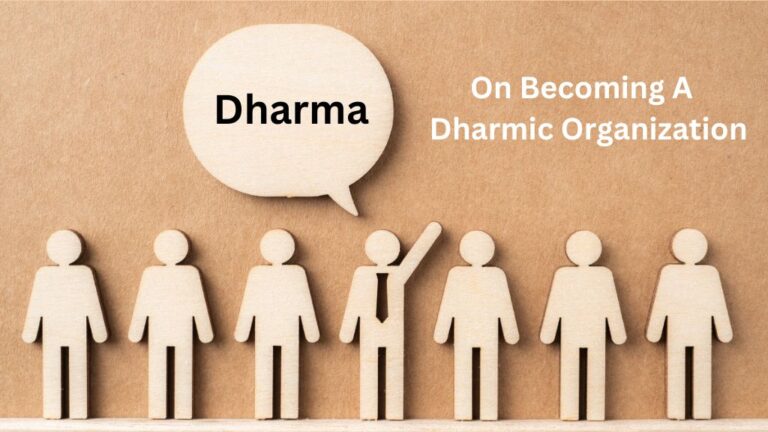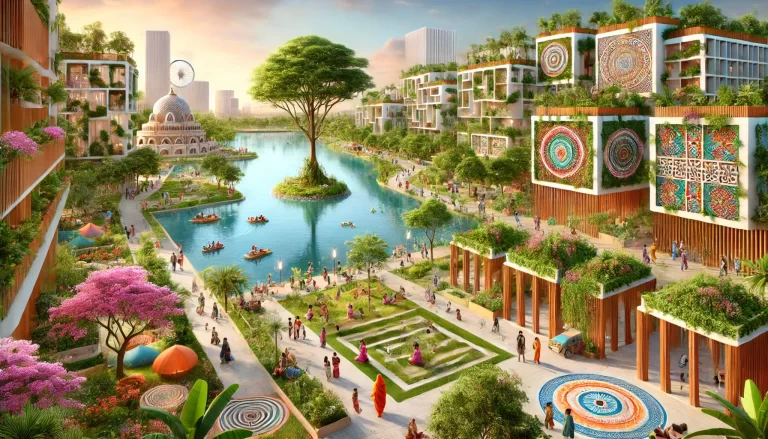Can we Imagine a Saner World?
How to Imagine a New World that is saner, wiser, healthier and balanced?
In an era dominated by rapid growth of large urban centers and the success and value of everything being measured in terms of size and scale, somewhere we have lost track of the purpose of human life and have become like hamsters on a wheel. Who is going to blow the whistle and stop the circus? Do we realise the insanity of this greedy, unending quest for more and more? What will it take to make us realize that this kind of unbridled exploitation of natural resources, rather a shameless exploitation of nature is not sustainable and that there will be a big price to pay? Who will be the first to say that the emperor has no clothes? Or are we all enjoying this game so much that we do not want it to stop no matter what? Some day, when we sit down to create the P & L statement for the world, we will find that we have lost more than what we have gained!
“Just as fire born out of wind (fanned into flame) is extinguished by the same wind, so also that which is born of imagination is destroyed by imagination itself.”
– Yoga Vasishta Sara
If I were to ask you what is the visible world made up of? Not in terms of the smallest building blocks but in terms of the big things that you see? And what are the categories of these big things? Let’s make a list, shall we?
Some of the big things we see:
- Large Apartment Complexes
- Large Office Blocks / IT Tech Parks
- Large Shopping Malls
- Huge Airports, Railway Stations, Bus Stations, Ports
- Large Stretches of Highways and Expressways
- Large Hotels and Hotel Chains
- Restaurants, Cafes, Bistros and Coffee Shops
- Big Schools, Colleges and Universities
- Large Hospitals
- Large factories and manufacturing plants
- Large Refineries
- Large Government Offices and Buildings Huge Army Cantonments / Bases
These are places which bring large groups of people together on a regular basis and there are different types of interactions that happen here. Now, the most prevalent and recurring designs of these types of buildings came out of someone’s imagination somewhere and somehow these designs start showing up everywhere. The same design gets replicated everywhere – whatever is commercially efficient, effective and expedient. In the process local culture, spirituality, cuisine, languages, aesthetics, tradition, history and environment – all take a beating and eventually you have a world where every town and city looks the same – concrete jungle made up of match box designs and millions of people running around like hamsters on the wheel. Thousands of hours of precious human life, that could have been used to realize life potential and help the world are spent navigating this concrete maze!
Should commercial efficiency be the only consideration when designing infrastructure? Is this happening because of a lack of imagination, a lack of motivation or a lack of knowledge? I would venture to say, all the above!
Now, what are some problems we are all experiencing in modern urban spaces all over the world (the differences are only in terms of scale)?
Air, Water and Sound pollution of course to begin with. So, what is new about it you might say! It is the scale and speed at which it is happening. Have we reached the point of no return yet?
Another issue is the proliferation of unhealthy food places and the proliferation of real world physical entertainment hubs that replicate the behavior of social media platforms in terms of how they manipulate the human mind through algorithms – all this is contributing immensely to the mental health crisis. Almost everything that is wrong in the world will eventually lead to mental health issues – it appears!
I was at one of the largest malls in Bengaluru yesterday. You must see the craze for experiences that has overtaken the modern man! Even villagers in their native attire are lining up to experience the place and spending so much of their hard-earned cash to eat stale, processed, unhealthy food. It was so interesting watching villagers feasting on pizzas – those overpriced things sold as “food” – and the craze for 3D games etc. I interviewed the people who work in those arcades and malls. Really young fellows. They said they are dead tired when weekend comes. Head spinning and headaches. The sound of those kids screaming and machines whirring playing in their heads when they try to sleep. Imagine what will happen to them in a few years. India is starting at a huge mental health crisis coming soon!
Disappearing third places ( a neutral place where people can meet and interact without too many strings attached or having to adhere to too many rules – a place where your position in the world did not matter and you could let your hair down) and increasing loneliness amongst people of all demographics – a paradox increasing loneliness in the midst of growing crowds. Lack of direct human to human socialization and an increase in social media interaction are complicating the issue. This may be more of an American problem at this time but it is going to be a problem everywhere pretty soon.
When we were growing up the front gate of the house was kind of a third place – Just stand there and neighbours would come out to talk. There used to be frequent power cuts and instead of being irritated, neighbours would come out and socialize. And if it was a full moon day, mothers and grandmothers would arrange a “beladingala oota” – a meal under the moonlight. Now, neighbors do not talk to each other. Ancient India had 3 types of third places I guess: bazaars, temples and taverns. But most of all the temples. The temples were the center of all life in general. Not anymore! All this is adding to the already worsening mental health crisis.
Increased interpersonal conflict and road rage can be experienced everywhere and there is increasing stress simply from living – even people with money and means are not immune to it. In other words life itself has become stressful or stress inducing. The increasing tech in our lives is creating a larger distance between us and the natural world. And we being children of the natural world – nature, miss it from the very core of our being but do not know it yet intellectually even though we are paying a heavy price for it.
Lack of space to walk – all available space claimed by residential complexes, commercial buildings, parking lots, malls etc – anything that supports the idea of commercial success and expansion at scale. There is also a lack of green spaces and reducing forest cover which not only leads to poorer air quality but also contributes to increasing stress and declining mental health. Add to this the lack of natural water bodies – lake beds in most cities are being taken over by developers who want to keep building. This is happening because of lack of regulation with respect to construction and development, lack of enforcement of existing rules and policies and lack of dharmic consciousness in builders, developers and city planners.
All this commercial activity creates “Dust” – dust has always been there but has anyone paid attention to how the composition of this dust has changed over the years? An investigation is likely to reveal shocking findings!
Increasing number of vehicles on the road – as the population of cities increase and automotive companies find buyers, the number of vehicles on the road will keep increasing. Has anyone thought of what is the upper limit? Does this ever come up when students are taught automotive engineering? Does this ever come up during deliberations on policy within government offices? Does this ever come up during discussions inside car companies? I guess no one wants to say the emperor has no clothes. Saying so would be detrimental to everyone’s interests! Or at least that is what they think!
Now everyone is talking about how celebrities like Virat Kohli and Anushka Sharma are abandoning India for greener pastures abroad. Apparently because the current public infrastructure in India has not caught up to the standards of the west. This is because our celebrities are caught up in the Artha-Kama complex. As Artha increases, Kama increases Geometrically. Their dilemma becomes where can I live the lifestyle that my wealth now affords me. Whereas, in a DAKM paradigm, as Artha increases, the Kama to do good, help the society that made you rich, pull up the downtrodden and take up revival and restoration of our spiritual places on a mission mode (a la Ahalya Bai Holkar) will arise. If on a spiritual path, every Kama that is fulfilled leads to more Vairagya (I like to think of the Dharmarthakamamoksha chaturvidha purushartha paradigm as the Learn, Earn, Spend, Renounce model of human life envisioned by sages of ancient India). On the other hand if you are not on the spiritual path, every kama that is fulfilled will give birth to more desires like Raktabeeja. Each one of these celebs leaving India has the power to transform India but they don’t have the motivation to do it. This is really unfortunate.
Puruṣārthas – The Cardinal Values of Life
1. While listing the Puruṣārthas (the four cardinal values of Life) namely Dharma, Artha, Kāma and Mokṣa, the order should not be altered. This sequence is perfect. For, Artha and Kāma must exist within the bounds of Dharma and Mokṣa.
2. Artha and Kāma are like mischievous cows. If you milk them, they would kick you. But if you milk them after tying their legs on either side to the pillars called Dharma and Mokṣa, they would pour nectar profusely. (Source: The nectarine nuggets of Sri Ranga Mahaguru)
But on the other hand for those seeking to live a spiritual lifestyle and craving for spiritual destinations, no other country in the world can match India. One cannot complete the list of spiritual destinations in one lifetime, you would need many lifetimes to visit all the spiritual places in India. As Swami Vivekananda said, the core strength and root power of India is spirituality. Any attempt to build power that is not based on that will not succeed. We have to know our core competence and as Sri Aurobindo said, our assigned role in the world.
Shivakumar GV sounds a word of caution: “Craving for new Experiences is an Eternal Reality because that is the ‘Nature of Srishti’. Since Moksha is perceived as the final difficult state it has to be articulated one level below. That Vairagya is an essential element for sustainable Artha Kama cannot be logically established. It can only be validated by experience.”
I am just counting my blessings for still being able to go and meditate in front of a Shivalinga installed by Bhima himself (in Kaivara)! I can drive up to Hampi and meditate in front of the Shiva Linga where Rama coronated Sugriva (Veerupaksha). I can drive 100 kms to Avani where Valmiki is supposed to have had an ashram. In the middle of all this crazy glittery experience seeking techno madness of Bengaluru I can find the experiences that I crave while others find the ones they crave! And both co-exist in the same place! I can drive to Basavanagudi and meditate in the Gavi Gangadharehwara temple – where Gautama Maharishi is supposed to have lived and done sadhana there. And there is a 900 year old temple (still functional and still active) a stone’s throw away from my office! Can I ask for anything more?!
Now, various statistics and studies on all the above issues is available plenty on the internet – in public domain. Yet, it is never a topic of major discussion. I find this at once strange, alarming and totally baffling!
It is being asked if “urbanization is dharmic?” My response is: It is more a question of how it is done, with what purpose it is done, who are the stakeholders and how they are affected by it, who benefits from it, who is harmed by it, and such considerations. We have dharmic design in the past with mokshic intent. These considerations would need to be addressed in the context of every key decision made.
People don’t understand how much of a difference the architecture and infrastructure of a city makes! We will only realize when we have lost it all! But all modern things also present a great opportunity: malls, metro stations, airports etc. Real estate developers can help to rebuild Bharat – literally and metaphorically – without too much hullabaloo; quietly, slowly, deliberately- they can bring about change through design. But most are not aware of it or lack that motivation.
Our IKS thinkers and leaders should allocate a whole army sized group to work with the real estate community. We can change the map of India in under ten years. You can build a community in such a way that people get healed just by living there. Your house can be designed to give you energy and heal you. That kind of knowledge is there in Bharat.
I have interviewed a whole bunch of architects and architecture students – our education lacks imagination. Majority of them have no awareness of India’s architectural genius. Vastu has been relegated to a religious practice! Yes! One reason is the ease and efficiency of copy and paste. But city councils should step up and impose localized design. And cities and states should not lose the flavor of local language and culture! Indians have to re-establish their relationship and understanding of Soundarya! Now all Indian cities are beginning to look and feel the same! I can’t tell between Ahmedabad, Bengaluru, Coimbatore anymore! Especially once you step into a mall!
We need to stop herding people all over the country into a single place, develop it to the point of ruin and then run to the next pristine place. Bengaluru is a prime example of this. We have untapped talent and potential all over the country! In every state every village – they just need guidance and support. It is not a good idea to push everyone to follow the Indian version of the American dream which has now turned into a nightmare.
Let every region develop in its own unique way. Let India have a basket of dreams based on Swabhava and Swadharma rather than pushing a unidimensional dream on everyone. Only then we can once again produce geniuses in the tens and hundreds if not thousands. We have to redefine success through redefining the purpose of life – let everyone discover their own purpose instead of trying to live up to a holographically projected purpose. No state has to try and imitate another state. The problem with basing growth strategies on imitation metrics from elsewhere through sheer laziness, lack of imagination and creativity is that you create more problems than the ones you solve!
Ultimately to ensure the wellbeing all human beings, Education, Architecture, Politics, Policymaking, Transportation, Entertainment, Food, Healthcare, Hospitality, Governance etc should be aligned with:
(1) Rta, Dharma, Nature’s Intent and Design – the governing principle of the universe and the right harmonious actions that arise from that
(2) Ultimate purpose of human life
(3) The actual yogic anatomy of the human body and the human being
(4) Natural design – nature has designed all things – male, female, animal, bird, insect etc. In nature there is design and not equality – that means everything has a purpose, a role to serve in the design of the overall system – which is the universe.
To create thriving cities and towns, we must address:
1. Individual Needs:
Physical: Clean water, nutritious food, and access to healthcare.
Mental: Libraries, learning spaces, and quiet zones.
Emotional: Art galleries and recreational spaces.
Spiritual: Meditation halls, temples, and sacred groves.
2. Societal Needs:
Community: Gathering spaces, festivals, and local governance mechanisms.
Entertainment: Venues for simple joys like music, dance, and theater.
3. Environmental Needs:
Biodiversity: Preserve habitats for animals and integrate trees as stakeholders in urban planning.
Sustainability: Focus on renewable energy and eco-friendly materials.
To summarize, Urban spaces should prioritize walkability, bike lanes, and communal gardens, enabling people to stay active without conscious effort. Design cities that promote mindfulness through quiet zones, meditation spaces, and workshops to help residents articulate and pursue their purpose. Implement food policies that make plant-based foods affordable and accessible. Develop infrastructure that fosters community interaction, such as family-friendly spaces, faith centers, and social clubs and green spaces and community gardens to help reduce loneliness and promote mental health.








One of those articles that should find place in our schools immediately for discussion among the children.
The 3rd place is a crucial takeaway and it always could be at our home entrance, street corner, temple and fortunately in Arjunabettahalli where I live, it’s intact.
We meet outside the Maramma, Arjuna & Basava Devastana where these temples have porches & the streets have benches.
The huge holy trees also have stone cladding so that we can sit and discuss.
Thank you Vinay Kulkarni ji for this wonderful thought provoking piece.
Would kindly request you to publish a Kannada version as am getting the Tamil, Malayalam & Hindi translations soon for your perusal.
Namaste

Stamp creator online: premium results without premium prices
stamp online maker free [url=https://www.make-stamp-online1.com/]https://www.make-stamp-online1.com/[/url] .
Продажа кабин для экскаваторов, погрузчиков и кранов
кабина на спецтехнику [url=http://xn—–6kceqhatfamjizg3a7au2dr1h5d.xn--p1ai/]http://xn—–6kceqhatfamjizg3a7au2dr1h5d.xn--p1ai/[/url] .
Широкий ассортимент кабин для спецтехники в наличии на складе
кабины спецтехника [url=https://xn—–6kceqhatfamjizg3a7au2dr1h5d.xn--p1ai/]кабины спецтехника[/url] .
Design stamps with handwritten fonts – personalize with stamp creator online
online stamp design maker [url=http://make-stamp-online-0.com/]http://make-stamp-online-0.com/[/url] .
Design custom business stamps with our online stamp maker
online stamp design maker [url=https://www.make-stamp-online-1.com/]https://www.make-stamp-online-1.com/[/url] .
wj947a
AI tool to generate cover letters that mirror job descriptions
cover letter ai [url=http://www.aicoverlettergenerator.pw]http://www.aicoverlettergenerator.pw[/url] .
Generate cover letters that pass ATS scans and human reviews
cover letter generate [url=http://createcoverletterfree.press/]http://createcoverletterfree.press/[/url] .
Top affiliate programs for making passive income while you sleep – Don’t miss out!
affiliate programs [url=https://affiliate-b1.com]https://affiliate-b1.com[/url] .
Датчик давления в шинах с доставкой по России: высококачественные модели для вашего авто.
датчик давления в шинах tpms [url=http://www.datchik-davleniya-v-shinah.ru/]http://www.datchik-davleniya-v-shinah.ru/[/url] .
Каркасный дом с летней кухней и зоной барбекю: идеальный отдых за городом
строительство каркасных домов спб [url=https://www.karkasnye-doma-vspb178.ru/]https://www.karkasnye-doma-vspb178.ru/[/url] .
Лизинг коммерческого транспорта: современные грузовики и фургоны с ежемесячной экономией до 30%
лизинг спецтехники [url=https://www.lizing-avto0.ru/specztehnika/]https://www.lizing-avto0.ru/specztehnika/[/url] .
Лизинг коммерческого транспорта для сельского хозяйства: техника в работе уже завтра
спецтехника лизинг [url=https://kommercheskiy-avtotransport-v-lizing.ru/specztehnika/]https://kommercheskiy-avtotransport-v-lizing.ru/specztehnika/[/url] .
Строительство каркасного дома под ключ: проекты и цены на 2025 год
строительство каркасных домов под ключ [url=https://karkasnye-doma-pod-klyuch-v-spb178.ru]https://karkasnye-doma-pod-klyuch-v-spb178.ru[/url] .
Надёжность и стиль: каркасные дома, которые прослужат поколениям
каркасный дом в спб [url=http://www.karkasnye-doma178.ru/]http://www.karkasnye-doma178.ru/[/url] .
Каркасный дом для дачи и постоянного проживания: выгодное строительство
каркасный дом под ключ спб [url=karkasnye-doma-pod-kluch178.ru]karkasnye-doma-pod-kluch178.ru[/url] .
Проект каркасного дома: как построить дом, который отражает ваш вкус
дома каркасные спб [url=https://www.karkasnye-doma-spb178.ru/]https://www.karkasnye-doma-spb178.ru/[/url] .
Каркасный дом: почему наша компания – это надежный партнер для строительства вашего идеального жилья
каркасные дома под ключ проекты и цены [url=https://www.spb-karkasnye-doma178.ru]https://www.spb-karkasnye-doma178.ru[/url] .
Временная регистрация на 3 месяца: Законные способы получения
временная регистрация на год [url=http://rega-msk99.ru/]http://rega-msk99.ru/[/url] .
Машинка на пульте управления: как устроить настоящие гонки прямо у себя дома с нашими моделями
машинка на ду [url=http://www.wildberries.ru/catalog/281617142/detail.aspx]http://www.wildberries.ru/catalog/281617142/detail.aspx[/url] .
От мелких поломок до полной замены – услуги сантехника от нашей компании решают всё
вызвать сантехника [url=vizov-santehnikavspb.ru]vizov-santehnikavspb.ru[/url] .
Лучшие услуги сантехника в вашем районе – оперативный выезд и доступные цены
сантехник на дом спб [url=http://www.santehniknadom-spb.ru]http://www.santehniknadom-spb.ru[/url] .
Cover letter generator with real-world examples and samples
cover leter generator [url=https://www.createcoverletterfree.com]https://www.createcoverletterfree.com[/url] .
Generate cover letters optimized for applicant tracking systems
coverletter generator [url=writingcoverletterai.com]writingcoverletterai.com[/url] .
Продвинутые тренажеры Матрикс для тех, кто хочет тренироваться как профессиональный спортсмен
матрикс фитнес [url=http://www.matriks-trenajeri.ru/]http://www.matriks-trenajeri.ru/[/url] .
Выгодные займы онлайн без скрытых комиссий и переплат
займ онлайн [url=https://vsezajmyonline.kz]https://vsezajmyonline.kz[/url] .
Микрокредиты с гибкими условиями погашения – удобно и выгодно
микрокредиты [url=https://allmikrokredits.kz/]микрокредиты[/url] .
Как правильно ухаживать за экраном для проектора, чтобы он прослужил дольше
экран проекционный [url=http://www.proekcionnye-ehkrany01.ru/]http://www.proekcionnye-ehkrany01.ru/[/url] .
Займы онлайн на карту срочно – получите деньги даже ночью и в выходные
онлайн займ [url=https://www.vsemiikrozajmy.kz/]https://www.vsemiikrozajmy.kz/[/url] .
Микрокредиты онлайн с минимальными процентами и удобными сроками
микрокредиты на карту [url=https://mikrokredityvsem.kz/]микрокредиты на карту[/url] .
Безопасные займы онлайн с гарантированным одобрением и мгновенным переводом
займ онлайн [url=http://www.news365.kz]http://www.news365.kz[/url] .
Клининг в Москве для тех, кто ценит комфорт: Удобное оформление заказа через мобильное приложение
лучшие клининговые компании в москве [url=kliningovye-kompanii-0.ru]kliningovye-kompanii-0.ru[/url] .
Клининг Москва — чистота везде: Работаем во всех районах и пригородах
клининговые компании москвы [url=https://www.kliningovye-kompanii-1.ru/]https://www.kliningovye-kompanii-1.ru/[/url] .
Автоматическое продление пропуска на МКАД: Забудьте о бюрократии и сосредоточьтесь на делах
пропуск мкад [url=propusk-na-mkad-v-moskvu1.ru]propusk-na-mkad-v-moskvu1.ru[/url] .
Профессиональный клининг с гарантией качества: Уборка квартир, офисов и коттеджей по выгодным ценам
клининг компания [url=http://klining-v-moskve0.ru/]http://klining-v-moskve0.ru/[/url] .
Прайс на клининг для самых требовательных: чистота, которая оправдает ваши ожидания и бюджет
сколько стоит клининг в москве [url=stoimost-kliningovykh-uslug.ru]stoimost-kliningovykh-uslug.ru[/url] .
A customized drone light show that offers a seamless blend of performance, style, and innovation
show drone [url=http://www.1drone-show.com]http://www.1drone-show.com[/url] .
Espectaculo de drones creativo: la nueva tendencia en entretenimiento para eventos
companias de espectaculos de drones [url=https://www.1show-de-drones.com]https://www.1show-de-drones.com[/url] .
Клининг для коттеджей и таунхаусов: Спецпредложения на уборку больших площадей
клининговая служба [url=klining-v-moskve0.ru]klining-v-moskve0.ru[/url] .
Авторазборка с удобной оплатой – заказывайте запчасти онлайн с быстрой доставкой
авторазборы [url=avtorzborka3-moskva.ru]avtorzborka3-moskva.ru[/url] .
Контрактный двигатель для вашего автомобиля – большой выбор и профессиональная помощь
контрактный двигатель купить [url=https://www.kontraktnye-dvigateli3-moskva.ru]https://www.kontraktnye-dvigateli3-moskva.ru[/url] .
Доставка бу запчастей по всей стране – экономьте время и деньги на ремонте
автозапчасти бу [url=https://zapchasti-bu3-moskva.ru/]автозапчасти бу[/url] .
Займы онлайн с прозрачными условиями и удобным графиком выплат
микрозаймы онлайн [url=https://vsemiikrozajmy.kz/]https://vsemiikrozajmy.kz/[/url] .
Микрокредиты до зарплаты – деньги быстро и без хлопот
микрокредиты в Казахстане [url=https://allmikrokredits.kz/]https://allmikrokredits.kz/[/url] .
Надежные займы онлайн с прозрачными условиями и без дополнительных платежей
займ [url=https://www.news365.kz/]https://www.news365.kz/[/url] .
Клининг в Москве для новоселов: Помощь с уборкой после ремонта + дополнительные скидки на комплекс услуг
клининговые компании москва рейтинг [url=http://www.kliningovye-kompanii-0.ru/]http://www.kliningovye-kompanii-0.ru/[/url] .
Клининг с оплатой по факту: Оплачивайте только после принятия работы
клининг москва [url=klining-v-moskve0.ru]klining-v-moskve0.ru[/url] .
Легализуйте передвижение — получите пропуск на МКАД за 24 часа
пропуск мкад [url=https://propusk-na-mkad-v-moskvu1.ru/]пропуск мкад[/url] .
Клининг Москва: Уборка по вашему графику — даже ночью или в выходные
клининговые компании [url=http://www.kliningovye-kompanii-1.ru/]http://www.kliningovye-kompanii-1.ru/[/url] .
Какие лучше покупать бу запчасти: Важные советы перед покупкой
запчасти бу [url=zapchasti-bu3-moskva.ru]zapchasti-bu3-moskva.ru[/url] .
Контрактный двигатель без пробега по России – гарантия надежности
купить мотор [url=http://kontraktnye-dvigateli3-moskva.ru/]http://kontraktnye-dvigateli3-moskva.ru/[/url] .
Авторазборка с огромным выбором запчастей – выгодные цены и быстрая доставка
авторазбор [url=http://www.avtorzborka3-moskva.ru/]http://www.avtorzborka3-moskva.ru/[/url] .
Need a corporate rubber stamp? Make one online for free today
stamp maker online [url=https://www.stamps1-creator.com/]https://www.stamps1-creator.com/[/url] .
Quick and easy rubber stamp design – free online maker with customizable options
free stamp maker online [url=make1-stamp-online.com]make1-stamp-online.com[/url] .
Лучшие цены на подписку Spotify для пользователей любого уровня
спотифай подписка купить [url=https://www.podpiska-spotify-1.ru/]https://www.podpiska-spotify-1.ru/[/url] .
Надежные и долговечные светодиодные светильники от проверенного производителя
прожектор светодиодный для уличного освещения [url=https://www.proizvodstvo-svetodiodnih-svetilnikov.ru]https://www.proizvodstvo-svetodiodnih-svetilnikov.ru[/url] .
Удобная парковка с камерой заднего вида — выбирайте лучшее решение
купить камеру заднего вида с разметкой [url=https://www.camera-zadnego-vida.ru/]https://www.camera-zadnego-vida.ru/[/url] .
Выгодные тарифы на подписку Spotify для меломанов
премиум подписка спотифай [url=https://www.podpiska-spotify-1.ru]https://www.podpiska-spotify-1.ru[/url] .
Разработка ППР для монтажа и демонтажа башенных кранов
тарифы ппр [url=razrabotka-ppr77.ru]razrabotka-ppr77.ru[/url] .
Пропуск в центр для Газели без задержек и лишних сложностей
пропуск в центр для газели [url=https://propusk-v-centr-dlya-gazeli.ru]https://propusk-v-centr-dlya-gazeli.ru[/url] .
Receive SMS online from anywhere in the world with no registration required
temporary number [url=https://rskswap.com/]temporary number[/url] .
Готовые решения для бизнеса – спецтехника Unisteam com под любые задачи
unisteam com
Комплексные программы лечения алкоголизма в наркологической клинике
клиника алкоголизма [url=https://platnaya-narkologicheskaya-klinika-01.ru]https://platnaya-narkologicheskaya-klinika-01.ru[/url] .
Монтаж сантехники в СПб – точные цены и консультации специалистов
расценки на сантехнические работы в санкт петербурге [url=https://remont-santehniki-price.ru/]расценки на сантехнические работы в санкт петербурге[/url] .
Установка систем отопления в СПб – актуальный прайс-лист услуг сантехника
сантехнические услуги цена [url=https://24-santehniki-price.ru/]https://24-santehniki-price.ru/[/url] .
Квалифицированный сантехник в СПб – доступные цены на монтаж
услуги сантехника цена [url=http://www.santeh1-montazh-price.ru/]http://www.santeh1-montazh-price.ru/[/url] .
Купить экран для проекторов с отражающим покрытием – четкое изображение даже при дневном свете
проекционный экран рулонный настенный [url=http://proekcionnye-ehkrany0.ru/proekcionnye-ekrany/nastennyj-ekran-dlya-proektora/]http://proekcionnye-ehkrany0.ru/proekcionnye-ekrany/nastennyj-ekran-dlya-proektora/[/url] .
Лечение наркозависимости и алкоголизма в специализированной наркологической клинике
наркологическая клиника телефон [url=https://www.platnaya-narkologicheskaya-klinika-01.ru/]https://www.platnaya-narkologicheskaya-klinika-01.ru/[/url] .
Опытный сантехник в СПб – цены на установку, замену, ремонт
прайс на сантехнические работы в спб [url=https://24-santehniki-price.ru/]прайс на сантехнические работы в спб[/url] .
Срочный вызов сантехника в СПб – честные цены без скрытых доплат
цены на сантехнические работы [url=http://remont-santehniki-price.ru/]http://remont-santehniki-price.ru/[/url] .
Современные стандарты безопасности – разработка технологической карты на погрузочно-разгрузочные работы
технологическая карта на погрузочно разгрузочные работы мостовым краном [url=https://www.tekhnologicheskie-karty.ru/]https://www.tekhnologicheskie-karty.ru/[/url] .
Практичная и стильная мебель для кафе – идеальные решения для вашего заведения
мебель для ресторанов [url=https://mebel-dlya-kafe.ru/]мебель для ресторанов[/url] .
Грамотный ремонт без проблем – рейтинг компаний по ремонту квартир
рейтинг строительных компаний по ремонту квартир в москве [url=http://www.remont-kvartir-reiting.ru/]http://www.remont-kvartir-reiting.ru/[/url] .
Выгодные предложения и качество монтажа – рейтинг оконных компаний
лучшие компании по установке окон [url=https://top-okon.ru/]https://top-okon.ru/[/url] .
Современные стандарты безопасности – разработка технологической карты на погрузочно-разгрузочные работы
технологическая карта на погрузочно разгрузочные работы [url=http://tekhnologicheskie-karty.ru/]http://tekhnologicheskie-karty.ru/[/url] .
Экран для проекторов с защитой от пыли – чистое изображение без помех
экраны для проектора в раме [url=https://www.proekcionnye-ehkrany0.ru/proekcionnye-ekrany/ekran-dlya-proektora-na-rame/]https://www.proekcionnye-ehkrany0.ru/proekcionnye-ekrany/ekran-dlya-proektora-na-rame/[/url] .
Практичная мебель для кафе – стильные стулья, столы и диваны
мебель для кафе купить [url=https://mebel-dlya-kafe.ru/]https://mebel-dlya-kafe.ru/[/url] .
Составление ППРК в кратчайшие сроки с минимальным участием заказчика
ппр на краны [url=https://pprk-msk.ru]https://pprk-msk.ru[/url] .
Рейтинг компаний по ремонту квартир – выгодные предложения и гарантия
ремонт квартир фирмы рейтинг [url=https://remont-kvartir-reiting.ru/]ремонт квартир фирмы рейтинг[/url] .
Клининг Москва: рейтинг лучших предложений от проверенных подрядчиков
хороший клининг в москве [url=http://www.kliningovye-kompanii-msk.ru]http://www.kliningovye-kompanii-msk.ru[/url] .
Клининг в Москве: рейтинг компаний с современным оборудованием
топ клининговых компаний [url=kliningovye-kompanii-msk1.ru]kliningovye-kompanii-msk1.ru[/url] .
Все включено: отдых в Абхазии с питанием и экскурсионной программой
отдых абхазия [url=https://otdyhabhazia01.ru/]отдых абхазия[/url] .
Точная и надёжная выездная поверка манометров для предприятий и ИП
провести поверку манометров [url=http://www.poverkamanomterov.ru/]http://www.poverkamanomterov.ru/[/url] .
Эффективное лечение зависимостей в платной наркологической клинике под наблюдением врачей
лечение наркозависимости нарколог [url=https://platnaya-narkologicheskaya-klinika-0.ru]https://platnaya-narkologicheskaya-klinika-0.ru[/url] .
Услуги сантехника по ремонту и замене сантехнического оборудования любой сложности
вызвать сантехника на дом в мурино [url=vyzov-santekhnika1-spb.ru/murino]vyzov-santekhnika1-spb.ru/murino[/url] .
Услуги сантехника с полной отчетностью и фотодокументированием работ
сантехник на дом спб недорого [url=vyzov-santekhnika-0.ru]vyzov-santekhnika-0.ru[/url] .
Психиатрическая клиника СПб с анонимным лечением и без осуждения
психиатрическая клиника петербурга [url=http://www.klinika-psikhiatrii-spb.ru]http://www.klinika-psikhiatrii-spb.ru[/url] .
Новинки сезона: пластиковые окна с современным дизайном
рехау пластиковые окна [url=http://plastikovye-okna-master.ru/]http://plastikovye-okna-master.ru/[/url] .
Врачи наркологи СПб предлагают вывод из запоя с выездом и сопровождением
центр вывод из запоя [url=https://www.vyvod-iz-zapoya-spb-1.ru/]https://www.vyvod-iz-zapoya-spb-1.ru/[/url] .
Строительство каркасных домов с гарантией до 10 лет
каркасные дома под ключ [url=http://www.karkasnye-doma-msk-pod-kluch.ru/]http://www.karkasnye-doma-msk-pod-kluch.ru/[/url] .
Строим каркасные дома с учетом климата и особенностей местности
дома каркасные под ключ проекты и цены [url=karkasnye-doma-msk-pod-kluch0.ru]karkasnye-doma-msk-pod-kluch0.ru[/url] .
Цветы с доставкой в офис, дом или ресторан — вовремя и без суеты
цветы в день рождения [url=http://www.cvety-s-dostavkoi.ru/rubric/buket-na-den-rozhdeniya/]http://www.cvety-s-dostavkoi.ru/rubric/buket-na-den-rozhdeniya/[/url] .
Покупка бу автозапчастей без посредников — напрямую с авторазборки
авторазборка [url=avtorazborka1-minsk.ru]avtorazborka1-minsk.ru[/url] .
Оригинальные бу автозапчасти с минимальным износом
бу запчасти минск [url=https://zapchasti-bu1-minsk.ru/]бу запчасти минск[/url] .
Качественные б/у двигатели — контрактные моторы в хорошем состоянии
контрактные двигателя [url=https://www.kontraktnye-dvigateli1-minsk.ru]https://www.kontraktnye-dvigateli1-minsk.ru[/url] .
Готовые проекты каркасных домов с планировками и фото
каркасный дом под ключ спб [url=http://www.karkasnye-doma-pod-kluch-spb.ru]http://www.karkasnye-doma-pod-kluch-spb.ru[/url] .
Каркасный дом под ключ — удобный и быстрый способ обзавестись жильём
каркасный дом [url=http://www.karkasnye-doma-pod-kluch-spb1.ru]http://www.karkasnye-doma-pod-kluch-spb1.ru[/url] .
Оптимальные решения для строительства каркасного дома
каркасный дом под ключ спб [url=http://www.karkasnye-doma-pod-kluch-spb1.ru]http://www.karkasnye-doma-pod-kluch-spb1.ru[/url] .
Экологичные и безопасные материалы для каркасного дома
каркасный дом под ключ [url=http://www.karkasnye-doma-spb-pod-kluch.ru]http://www.karkasnye-doma-spb-pod-kluch.ru[/url] .
Выбирайте каркасный дом с эргономичным расположением комнат
строительство каркасных домов в спб [url=https://karkasnye-doma-spb-pod-kluch0.ru/]https://karkasnye-doma-spb-pod-kluch0.ru/[/url] .
Уютный и энергоэффективный каркасный дом с возможностью зимнего проживания
каркасные дома санкт петербург [url=http://karkasnye-doma-pod-kluch-spb.ru/]http://karkasnye-doma-pod-kluch-spb.ru/[/url] .
Как выгодно оформить лизинг на коммерческий транспорт для ИП и ООО
лизинг оборудования компании [url=http://lizing-kommercheskogo-transporta1.ru/oborudovanie/]http://lizing-kommercheskogo-transporta1.ru/oborudovanie/[/url] .
Строим уютные каркасные дома с подвалом и чердаком
каркасный дом санкт петербург [url=http://www.karkasnye-doma-spb-pod-kluch0.ru]http://www.karkasnye-doma-spb-pod-kluch0.ru[/url] .
Aerial drone show with coordinated lights and artistic visuals
drone show cost [url=https://www.drone0-show.com/]https://www.drone0-show.com/[/url] .
Лизинг коммерческого транспорта в кратчайшие сроки и без лишней волокиты
купить коммерческий транспорт в лизинг [url=lizing-kommercheskogo-transporta1.ru]lizing-kommercheskogo-transporta1.ru[/url] .
Tecnologia y creatividad unidas en un show de drones espectacular
compañías de exhibición de drones [url=show0-de-drones.com]show0-de-drones.com[/url] .
Печать на футболках для творчества, бизнеса и вдохновения
печать на футболке москва [url=https://pechat-na-futbolkah1.ru]https://pechat-na-futbolkah1.ru[/url] .
Drone shows for large and small events with flexible booking options
drone shows [url=http://www.drone0-show.com]http://www.drone0-show.com[/url] .
Магазин шин и дисков с бонусной программой и скидками
интернет магазин шины [url=https://shini-kupit-v-spb.ru]https://shini-kupit-v-spb.ru[/url] .
Калькулятор досрочного погашения для правильного планирования бюджета
кредитный калькулятор с досрочным [url=http://www.finanspro24.ru]http://www.finanspro24.ru[/url] .
Проверить кредитный рейтинг важно, если вы планируете взять кредит
узнать свой кредитный рейтинг [url=https://dengivperedservice.ru/]узнать свой кредитный рейтинг[/url] .
Выберите лучшее рефинансирование кредита и начните экономить уже сегодня
рефинансирования кредитов других банков [url=https://kapitalinfo-team.ru/]рефинансирования кредитов других банков[/url] .
Кредитный рейтинг влияет на вашу финансовую репутацию больше, чем вы думаете
кредитный рейтинг бесплатно [url=https://budgetmasterexpert.ru/]кредитный рейтинг бесплатно[/url] .
Как оформить кредит без отказа, даже с плохой кредитной историей
какой банк дает кредит без отказа [url=https://investrost1.ru/]https://investrost1.ru/[/url] .
Качественные контрактные моторы в наличии и под заказ
контрактный двигатель [url=https://www.kontraktnye-dvigateli1-minsk.ru]https://www.kontraktnye-dvigateli1-minsk.ru[/url] .
Каркасный дом под ключ с гарантией качества и фиксированной ценой
дома каркасные [url=http://karkasnye-doma-pod-kluch-spb.ru/]http://karkasnye-doma-pod-kluch-spb.ru/[/url] .
Быстрый поиск бу запчастей с фильтрами по марке и модели
автозапчасти б у [url=http://www.zapchasti-bu1-minsk.ru]http://www.zapchasti-bu1-minsk.ru[/url] .
Проверенные запчасти с авторазборки без переплаты
авторазборки [url=http://avtorazborka1-minsk.ru/]http://avtorazborka1-minsk.ru/[/url] .
Каркасный дом как альтернатива квартире в городе — свобода и комфорт
строительство каркасных домов спб [url=https://karkasnye-doma-spb-pod-kluch.ru/]строительство каркасных домов спб[/url] .
Выгодный лизинг на коммерческий транспорт от ведущих лизингодателей
лизинг грузовых автомобилей [url=http://www.lizing-kommercheskogo-transporta1.ru/gruzovye-avtomobili/]http://www.lizing-kommercheskogo-transporta1.ru/gruzovye-avtomobili/[/url] .
Теплые и экологичные каркасные дома для постоянного проживания
дома каркасные под ключ москва [url=https://www.karkasnye-doma-msk-pod-kluch.ru/]https://www.karkasnye-doma-msk-pod-kluch.ru/[/url] .
Индивидуальные каркасные дома, соответствующие всем нормам и стандартам
каркасные дома под ключ проекты и цены [url=https://www.karkasnye-doma-msk-pod-kluch0.ru]https://www.karkasnye-doma-msk-pod-kluch0.ru[/url] .
Transforma tu evento con un show de drones deslumbrante
espectáculo de drones [url=https://show0-de-drones.com/]https://show0-de-drones.com/[/url] .
Футболки с оригинальной печатью под брендинг и рекламу
принт на футболке [url=pechat-na-futbolkah1.ru]pechat-na-futbolkah1.ru[/url] .
Надежный калькулятор досрочного погашения для всех типов займов
кредитный калькулятор с досрочным погашением онлайн [url=https://finanspro24.ru/]кредитный калькулятор с досрочным погашением онлайн[/url] .
Гарантированное качество и оригинальность всех шин в магазине
авторезина интернет магазин [url=http://www.shini-kupit-v-spb.ru/]http://www.shini-kupit-v-spb.ru/[/url] .
Проверить кредитный рейтинг поможет понять, на какие суммы можно рассчитывать
как узнать свой кредитный рейтинг [url=https://dengivperedservice.ru/]как узнать свой кредитный рейтинг[/url] .